|
|
|
|
|
|
|
Fresh water scarcity is predicted to become the greatest single threat to international stability, human health, global food supply and even the spectre of war over water. According to the World Resources Institute, within 25 years, more than half of the world population will be suffering severe fresh
water shortages. Latest research shows vetiver's extraordinary ability to absorb and tolerate extreme levels of nutrients and consume a large quantity of water in the process of producing a massive growth. These attributes indicate that vetiver is ideally suitable for treating contaminated and polluted wastewater from industries as well as domestic discharge. This includes: wastewater volume or quantity by seepage control, land irrigation and wetland; wastewater quality by trapping sediment and particles, tolerating and absorbing pollutants, and heavy metals and detoxification of industrial, mining and agrochemical wastes. Significant advances have been made in the use of vetiver grass in computer modelling (KB706) to treat industrial wastewater. For this application, not only all known aspects of vetiver physiological and morphological attributes, but also its potential were carefully studied and analysed in the calibration process. The results again establish and confirm our admiration for this unique plant.
more (KB990) |
|
|
|
|
|
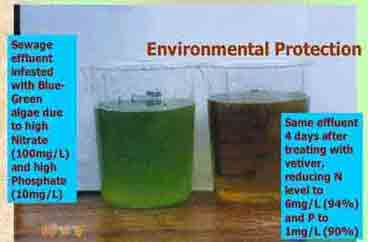 |
|
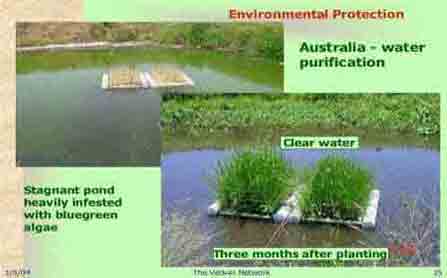 |
|
|
| To the right is an example of how vetiver can be floated and grown hydroponically on a sewage/ wastewater pond. It will remove the equivalent of 10 tons of nitrogen per ha per annum (149KB). Immagine the potential for cleaning up the hundreds of thousands community ponds and tanks in South and East Asia. Turning them from stagnating water supplies with little or low oxygen content to clean and clear water. |
|
|
|
|
|
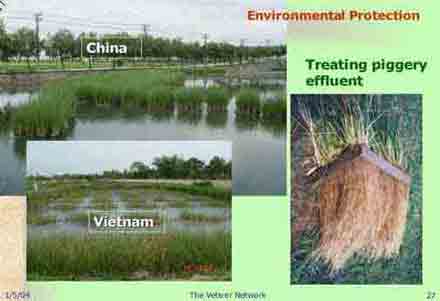 |
|
| The photos to the right show how vetiver can be used for cleaning up wastes from pig farms in China (KB17) and Vietnam. The floating pontoons can be dragged to shore and the grass cut for forage every three orv four weeks. This system of hydroponics will produce over 120 tons of vetiver dry matter per ha per annum. |
|
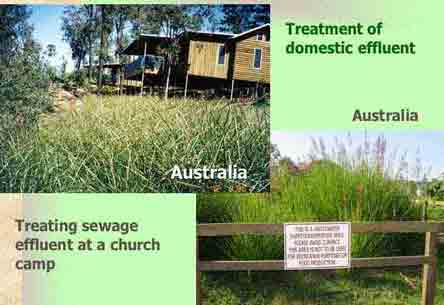 |
|
|
|
| Vetiver grass will take up water very quickly and therefore is an effective way of treating the tertiary effluent from small sewage systems and septic tanks. The image on the left is one such an example and could be used in rural villages throughout the developing world to dry up wet spots that otherwise accumulates water and provides breeding ground for mosquitoes and other health hazards. |
|
| Stotts Creek Landfill is a major waste depot of the Tweed Shire receiving wastes from both Tweed Heads and Murwillumbah townships and neighboring local government areas. Disposal of leachate is a major concern of the Shire as the landfill site is close to agricultural areas. An effective and low cost leachate disposal system (KB 206) is needed, particularly during summer high rainfall season. As vetiver grass has a very high water use and nutrient uptake rates, and it is tolerant to elevated levels of heavy metals and other adverse conditions, it is best suited for effluent and leachate disposal. Leachate quality at Stotts Creek Landfill is low in heavy metals but relatively high in salts and nutrients. Currently leachate and runoff from the landfill site are stored in ponds at the foot of the mound. During dry periods the leachate is irrigated onto the top of the completed waste mound where it evaporates or transpires into the atmosphere. During heavy rainfall the leachate overflows into a system of wetlands and then to a local creek. Following capping and topsoiling, vetiver has been planted on the surface of the completed waste mound and irrigated with leachate from collecting ponds. So far an area of 3.5 ha has been planted with vetiver and the land area will be extended to about 6 ha in total late in 2003. Results to date has been excellent, as soon as an area was planted it was irrigated with leachate by overhead spray irrigation and almost 100% establishment was achieved. |
|
|
|
|
|
|
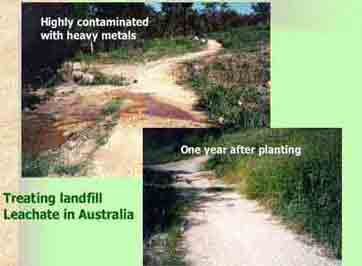 |
|
|
|
|
|
|
|
| The Esk Shire Council has recently installed a Vetiver Grass Wetlands System (MB 1.3) to treat sewerage effluent at Toogoolawah in South East Queensland. The aim of this scheme was to improve water quality before the effluent discharges to the natural wetlands. The biggest problem with the quality of the effluent is its high nutrient loading. With the recent changes to license conditions imposed by the Environmental Protection Agency, the existing treatment plant no longer complies with the license and an upgrade of the plant was required. The effluent is being treated in two stages: (1) Preliminary treatment of the pond effluent in situ by floating pontoons placed in the ponds, and by vetiver planting around the edges of the three sewerage ponds. (2) Main treatment by vetiver wetlands, once the effluent exits the sewerage ponds it passes through a Vetiver Grass contoured wetlands constructed over 3 hectares of the land. The Vetiver Grass wetlands have been constructed in rows following the contours to allow goodcontact between the grass and the effluent. The Vetiver Grass takes up the water and in particular the grass will remove the nutrients from the water that passes through it. As Vetiver Grass system is very effective in removing nutrient loads, it is expected that once the wetlands is properly established there should be no release of sewerage effluent from the treatment plant except in times of heavy rainfall. This scheme will provide a large-scale prototype of possible sewerage treatment schemes that can be used throughout western Queensland and other locations where there is plenty of land and where the local government doesn’t want to pay for installing and operating high cost solutions. |
|
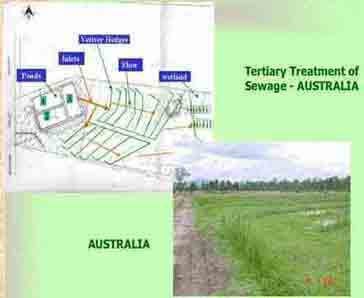 |
|
|
|
|
|
|
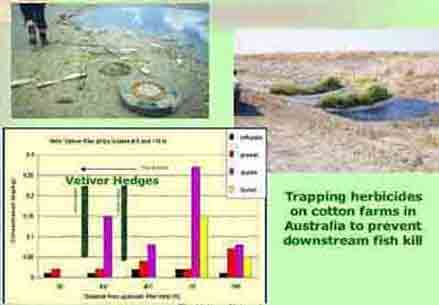 |
|
| Vetiver grass will remove (more than 90%)excess nutrients and heavy metals, it will also break down excess herbicides and pesticides. The latter often pollute down stream water and can cause fish kill. Strategically placed vetiver hedgerows can remedy these problems. more (MB1.1) |
|
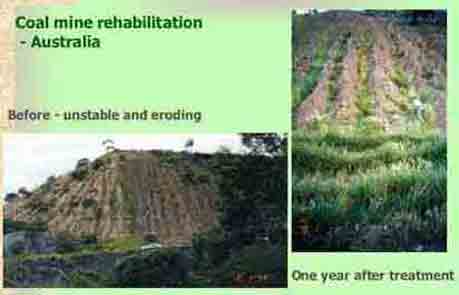 |
|
|
|
|
Unique morphological characteristics include a massive finely structured and deep root system capable of reaching 3-4m in the first year. In addition vetiver is tolerant to extreme climatic variation such as prolonged drought, flood, submergence and extreme temperature. It is also tolerance to wide range of soil pH, from 3.0 to 10.5, highly tolerant to soil salinity, sodicity, acidity, Aluminium and Manganese toxicities, and heavy metals such as Arsenic, Cadmium, Chromium, Nickel, Lead, Zinc, Mercury, Selenium and Copper in the soil. In Australia vetiver has been successfully used to stabilise mining overburden and highly saline, sodic, magnesic and alkaline (pH 9.5) tailings of coal mine and highly acidic (pH 2.7) and high arsenic tailings of gold mines. In South Africa vetiver has been used very effectively to stabilise/rehabilitate "slimes dams". Rehabilitation trials at de Beers diamond mine slimes dams confirms that vetiver can survive in very harsh environments where surface temperature of the black kimberlite exceeds 550C. Wastes and slimes dams from platinum and gold mines have also been successfully rehabilitated with Vetiver. more (KB 69)
To the right, an example of mine stabilization on a gtold slimes dam in Australia
|
|
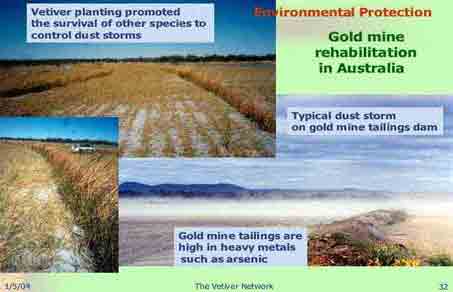 |
|
|
|
|
|
|
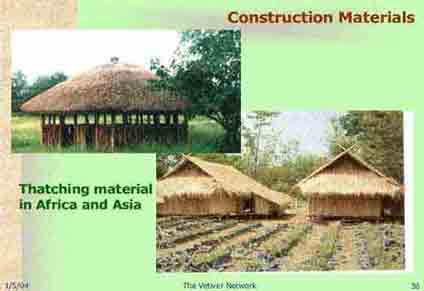 |
|
| In addition to being used to perform specific functions in soil and water conservation, environmental protection, etc., vetiver plant has also a few other uses (KB269) e.g. as forage for livestock, ornamentals, and miscellaneous other uses. Harvested vetiver leaves, culms and roots are utilized after some degree of processing in various ways, e.g. as input of agriculture-related activities (mulch, compost, nursery block / planting medium, animal feed stuff, mushroom cultivation, botanical pesticides, and allelopathy), handicraft and art works, medicinal applications, fragrance, input of construction-related activities (roof thatch, hut, mud brick, vetiver-clay composite storage bin, veneer / fiber board, artificial pozzalans, ash for concrete work, and straw bale), containers (pottery, melamine utensils, water containers), bouquet, energy sources (ethanol, green fuel), industrial products (pulp and paper, panel), and miscellaneous other utilization. |
|
 |
|
|
|
|
|
|
|
|
|
|
|
|
|
|
|
|
|
|
|
|
|
|
|










